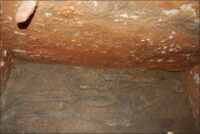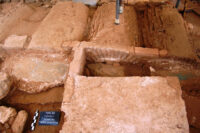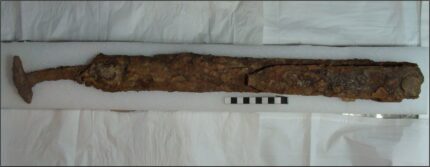 The tomb of a Goth warrior buried with a bent sword has been found in an early Christian basilica in Thessaloniki. It is the first burial of a soldier with weapons from this period ever discovered in the region of Macedonia.
The tomb of a Goth warrior buried with a bent sword has been found in an early Christian basilica in Thessaloniki. It is the first burial of a soldier with weapons from this period ever discovered in the region of Macedonia.
The remains of the three-aisled basilica from the 5th century were discovered in 2010 during an archaeological survey in advance of subway construction. It had been built over a preceding chapel from the 4th century that is believed to be the oldest Christian church in Thessaloniki. Seven vaulted tombs were found under the south aisle. These must have been Christians of importance in the city to be honored with burial in the basilica.
 One arch-shaped tomb contained the skeletal remains of the an adult man interred with weapons including a shield boss and spearhead. The best preserved of his weapons was his spatha, a short sword used by Roman cavalry in the late Imperial period(3rd-5th c.). It had been deliberately folded, an extremely rare phenomenon in urban Greece at this time. The practice was more common in Celtic and Germanic populations. Romans did not bend swords, and the practice of weapons burial is unusual in a Christian funerary context from this period. It was considered a pagan ritual, so finding them in a basilica grave is unexpected. It’s an indication of the high rank he probably held in the army.
One arch-shaped tomb contained the skeletal remains of the an adult man interred with weapons including a shield boss and spearhead. The best preserved of his weapons was his spatha, a short sword used by Roman cavalry in the late Imperial period(3rd-5th c.). It had been deliberately folded, an extremely rare phenomenon in urban Greece at this time. The practice was more common in Celtic and Germanic populations. Romans did not bend swords, and the practice of weapons burial is unusual in a Christian funerary context from this period. It was considered a pagan ritual, so finding them in a basilica grave is unexpected. It’s an indication of the high rank he probably held in the army.
The bent sword is a clue that the soldier was a “Romanized Goth or from any other Germanic tribe who served as a mercenary (foederatus) in the imperial Roman forces,” Maniotis wrote in the email. The Latin word “foederatus” comes from “foedus,” a term describing a “treaty of mutual assistance between Rome and another nation,” Maniotis noted. “This treaty allowed the Germanic tribes to serve in the Roman Army as mercenaries, providing them with money, land and titles. [But] sometimes these foederati turned against the Romans.”
The archaeological team recently found ancient coins at the site, so they plan to use these, as well as the style of the sword’s pommel, or the knob on the handle, to figure out when this soldier lived, Maniotis noted.
